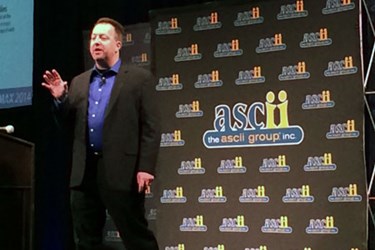From ASCII Atlantic City: The Perpetually Valuable MSP

By Jim Roddy, VP of Marketing, RSPA

“Thought leadership” is a phrase thrown around rather casually by companies and marketers, especially in the IT channel. True thought leadership includes having genuine, original ideas and then presenting those concepts to everyone in your constituency.
At the ASCII Success Summit October 23 in Atlantic City, Dave Sobel, the director of partner community for MAXfocus, provided legitimate thought leadership when presenting his organization’s ideas on The Perpetually Valuable MSP.
The basic formula is:
Present Fitness + Future Vision x Agile Development = Business Agility
That’s going to require some explanation, right? I didn’t capture every detail of Sobel’s action-packed 25-minute talk, but two main segments of his presentation will give you the gist of The Perpetually Valuable MSP.
The Reasons We Got Into Managed Services
Sobel detailed five reasons solutions providers transitioned to the managed services model, and he drew a parallel why many customers prefer managed services. These are foundational to being a valuable MSP.
- Resources
- Customer: Scheduled, proactive management of IT resources to maintain up time and peak performance
- MSP: Predictable resource requirements that allow accurate planning and investments
- Consistency
- Customer: Consistent, reliable budget planning based on a clearly defined contract commitment
- MSP: Consistent, reliable revenue based on long-term commitments and regular payments
- Engagement
- Customer: Access to a team of experts in real-time to quickly resolve a broad range of technical challenges
- MSP: Enhanced control of customer accounts that comes from ongoing planned engagement
- Optimization
- Customer: Leverage of advanced skills and training to optimize the value and performance of IT systems
- MSP: Insights into future customer needs for IT systems and services
- Partnership
- Customer: Comprehensive services to maintain systems at peak performance to prolong the lifecycle of IT investments
- MSP: Ability to leverage tools and automation to scale capacity significantly beyond the direct limits of staff, which yields higher margins
Sobel articulates an attitude I’ve heard repeatedly from successful, stable solutions providers. “The MSP can predict their revenue, and they’re so happy when they know at the beginning of the month they’ll have enough revenue to pay off all their bills,” Sobel says.
As president of a small business who utilizes a managed services provider, I’ve also experienced this: “When customers write those checks, they know what they’re going to pay and the result they’re going to get for that cost,” Sobel says.
Perpetual Value Is A Result Of Systematic Innovation
“Managed services by its very nature is about consistency and standardization,” Sobel explains. “So how does an MSP continue to keep themselves positioned well? How did they embrace both innovation and consistency? How do you put business agility into practice?”
Sobel says MAXfocus has identified 10 basic MSP best practices around agility:
- Rolling plans and forecasts. The best solutions providers do this quarterly and adjust their plan for a rolling 12-month plan. It makes them much more able adapt to market forces and their customer needs.
- Conduct non-technical customer meetings. Sobel recommends MSPs say to their customers, “I need to understand your outcomes and what business goals you’re trying to accomplish so I can be sure my business accommodates that.”
- Run one test at a time. Only test one variable at a time to know if the change is effective.
- Track key revenue metrics. For example, track your percent of revenue from new service offerings. Track revenue growth of core business vs. new business revenue growth.
- Test new offerings with rapid deployment. Don’t wait for your solution to be perfect before launching it. “If you want your product to be perfect at launch, it will never launch,” Sobel says. “Get it out when it is ‘minimally viable.’ Constantly test, then constantly test and refine.”
- Argue in the alternative. Assign someone to argue against your new product. Have them try to poke holes in your offering before you launch it. This uncovers sales objections and product shortcomings.
- Non-revenue compensation metrics. If you don’t specifically add new product lines into your sales reps’ compensation, they won’t sell them.
- Allocate people correctly. “You have to assign people to launch new products to make sure that it happens,” Sobel says. “It won’t happen in anyone’s spare time. There has to be accountability.”
- Define a specific launch methodology. The more you launch new products inside of a planned system, it will make it easier for your organization to launch new products.
- Define a specific de-commission methodology. “There needs to be a specific, predictable way of doing this to move customers to a new offering,” Sobel says. “By doing it over and over again the same way, you’ll get good at it.”
“The best MSPs have visions for where their model is going to go, and they are constantly integrating that into their business,” Sobel comments. “They ask what external factors — like the economy and new trends — will affect their business? What are the internal factors — like your resources and company finances? What are the customer factors — what are their business and trends in their vertical markets?
“None of these are good or bad. Understanding them is just a good way of doing business,” Sobel said. “Typical solutions providers don’t think about these things. By thinking about these best practices, you’ll be able to identify trends and respond to them faster than the typical solutions provider.”
The ASCII Success Summit – Atlantic City is being held October 22-23 at the Bally’s Atlantic City Hotel and Casino in New Jersey. It is the last of eight solution provider-focused conferences ASCII hosted in 2014. For more information on ASCII, go to www.BSMinfo.com/go/InsideASCII.
